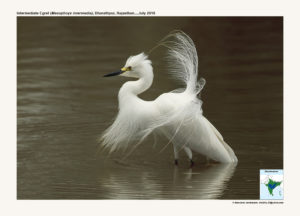Intermediate Egret

Intermediate Egret Ardea Intermedia
Etymology:
- Ardea : ardea heron. {In Roman mythology the town of Ardea, capital of the Rutuli, was razed to the ground, and from the ashes rose a lean, pale bird, shaking the cinders from its wings and uttering mournful cries}
- Intermedia : Latin word for Intermediate, In between
Distribution in India: Wide spread resident except for Himalayas and Rajasthan. Local winter migration in Central India
Description: Size of 56–72 cm; wt. of 400–500 g; wingspan 105–115 cm. They are all-white plumage, generally dark legs and a thickish yellow bill with blackish tip. Breeding birds may have a reddish or black bill, greenish yellow gape skin, loose filamentous plumes on their breast and back, and dull yellow or pink on their upper legs. No pronounced kink in the neck and the gape line ends below the eye. The juvenile is like adult, but has faint yellowish wash to plumage
Habitat: It is found in lakes, rivers, canals, ponds, lagoons, marshes and flooded land, the bird prefers open locations to dense cover. Also seen in mangrove areas, swamps, mudflats, sandy beaches and reefs. The bird often moves about among cattle or other hoofed mammals.
Food Habits: It eats insect, especially grasshoppers, crickets, flies , and moths, as well as spiders, frogs, and earthworms . It stalks their prey in shallow water, often running with raised wings or shuffling their feet to disturb small fish, or may stand still and wait to ambush prey.
Breeding Habits: They nest in colonies, which are often found around bodies of water. The colonies are usually found in woodlands near lakes or rivers, in swamps, or on small inland or coastal islands, and are sometimes shared with other wetland birds. The nest is a small untidy platform of sticks in a tree or shrub constructed by both parents. Sticks are collected by the male and arranged by the female, and stick-stealing is rife. The clutch size is three to five eggs, incubated by both adults for 21 to 25 days before hatching. The chicks begin to leave the nest and climb around at 2 weeks, fledge at 40 days and become independent at around the 45th day.